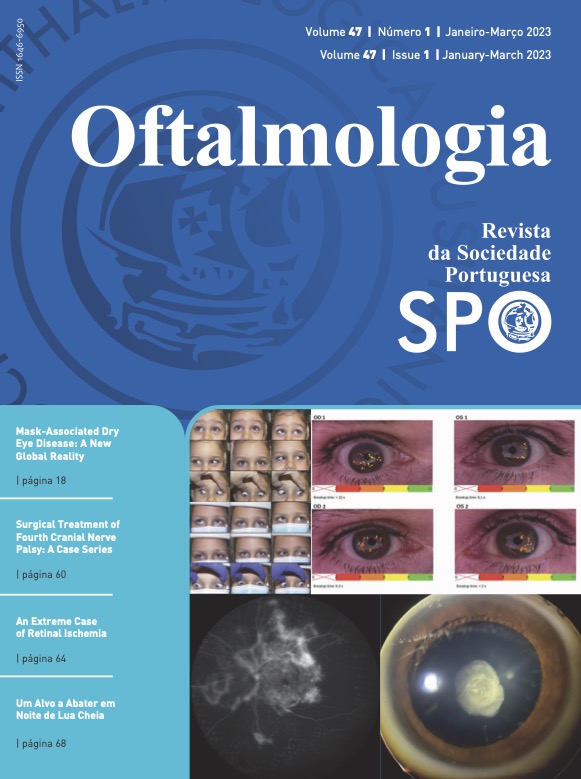Tear Film Mediators After Corneal Cross-Linking: Methodology Validation
DOI:
https://doi.org/10.48560/rspo.25967Keywords:
Corneal Cross-Linking, Cytokines, Keratoconus Inflammation Mediators, TearsAbstract
Introduction: Currently, the gold-standard treatment of progressive keratoconus (KC) is corneal collagen cross-linking (CXL), in which riboflavin and ultraviolet-A radiation increase the corneal biomechanical rigidity, arresting progression. However, post-operatory results vary significantly among patients. Although it has been suggested that corneal thickness, cone location and patient’s age are important factors, their contribution is controversial. The reason for this variability remains obscure. This project aims to find biomarkers that could explain the variability within surgical results after corneal CXL by investigating the correlation between the local corneal inflammatory environment and these results. We hypothesize that better post-operatory results are related to a reduction in the inflammatory cytokine levels in the patients’ tear film. Ultimately, we aim to optimize the patients’ surgical outcomes according to their corneal inflammatory environment.Methodology: The research protocol was established after testing different sample collection methods. Patients are interviewed to assess their medical history and relevant habits. Their corneal tomographic and best corrected visual acuity data are registered before and 6 months after surgery. The patient´s tear film is sampled twice 6 months apart using Schirmer strips, as the volume yield is larger compared to direct methods (microcapillary tubes or micropipettes), which are more difficult to perform and require stimulation or the instillation of saline into the cul-de-sac, originating reflex tearing. The samples are analyzed for their total protein content (BCA Protein Assay Kit) and cytokine concentration using Multiplex technology (Th1/Th2/Th9/Th17 Cytokine 18-Plex Human Procarta-Plex™ Panel) and not ELISA, as we tried before. Statistical analysis to assess sample differences and the correlation between cytokine concentration and tomographic indexes and visual acuity values for each group and subgroup is performed at 6 months.
Results: Twenty patients and eight control subjects have been enrolled in the study and the first collection of tears has been carried out. CXL surgeries for the twenty patients were per-formed from October 2020 to September 2021. Two samples were lost due to excessively length of dry Schirmer strip, which we improved by cutting the dry portion. Additionally, the tear fluid from the first eight samples from patients and from control participants was successfully processed for their total protein content.
Conclusion: Tear film analysis poses several challenges concerning the small amount of material available without reflex production. This fact precludes the use of conventional ELISA, requiring multiplex modified technology. When dealing with tears it is also important to avoid contamination by using sterilized material, to avoid dilution and to establish an efficient flow of samples from the clinic to the laboratory. This pilot study enabled to identify several methodological frailties and to establish a solid research protocol that can be replicated by other researchers. Understanding the correlation between inflammatory cytokines and surgical outcomes of CXL may allow for the optimization and personalization of CXL. In addition, the results of this research protocol are expected to establish prognostic factors for CXL-related surgical outcomes, ultimately improving the quality of life of KC patients.
Downloads
References
Mas Tur V, MacGregor C, Jayaswal R, O’Brart D, Maycock N. A review of keratoconus: Diagnosis, pathophysiology, and genetics. Surv Ophthalmol. 2017;62:770-83. doi: 10.1016/j.survophthal.2017.06.009.
Rabinowitz YS. Keratoconus. Surv Ophthalmol. 1998;42:297- 319. doi: 10.1016/s0039-6257(97)00119-7.
Wisse RP, Kuiper JJ, Gans R, Imhof S, Radstake TR, Van der Lelij A. Cytokine Expression in Keratoconus and its Corneal Microenvironment: A Systematic Review. Ocul Surf. 2015;13:272-83. doi: 10.1016/j.jtos.2015.04.006.
Ferrari G, Rama P. The keratoconus enigma: A review with emphasis on pathogenesis. Ocul Surf. 2020;18:363-73. doi: 10.1016/j.jtos.2020.03.006.
Nottingham J. Practical observations on conical cornea, and on the short sight, and other defects of vision connected with it. London: J. Churchill; 1854.
Ionescu C, Corbu CG, Tanase C, Jonescu-Cuypers C, Nicula C, Dascalescu D, et al. Inflammatory Biomarkers Profile as Mi- croenvironmental Expression in Keratoconus. Dis Markers. 2016;2016:1243819. doi: 10.1155/2016/1243819.
Galvis V, Sherwin T, Tello A, Merayo J, Barrera R, Acera A. Keratoconus: An inflammatory disorder? Eye. 2015;29:843–59. doi: 10.1038/eye.2015.63.
Lema I, Durán JA. Inflammatory molecules in the tears of patients with keratoconus. Ophthalmology. 2005;112:654–9. doi: 10.1016/j.ophtha.2004.11.050.
Kolozsvári BL, Petrovski G, Gogolák P, Rajnavölgyi É, Tóth F, Berta A, et al. Association between mediators in the tear fluid and the severity of keratoconus. Ophthalmic Research. 2013;51:46–51. doi: 10.1159/000351626.
Fodor M, Vitályos G, Losonczy G, Hassan Z, Pásztor D, Gogolák P, et al. Tear Mediators NGF along with IL-13 Predict Keratoconus Progression. Ocul Immunol Inflamm. 2021;29:1090- 101. doi: 10.1080/09273948.2020.1716024.
Kobashi H, Rong SS. Corneal Collagen Cross-Linking for Keratoconus: Systematic Review. Biomed Res Int. 2017;2017:8145651. doi: 10.1155/2017/8145651.
Subasinghe SK, Ogbuehi KC, Dias GJ. Current perspectives on corneal collagen crosslinking (CXL). Graefes Arch Clin Exp Ophthalmol. 2018;256:1363-84. doi: 10.1007/s00417-018-3966-0.
Spoerl E, Huhle M, Seiler T. Induction of Cross-links in Corneal Tissue. Exp Eye Res. 1998;66:97–103.
Wollensak G, Spoerl E, Seiler T. Riboflavin/ultraviolet-a–induced collagen crosslinking for the treatment of keratoco- nus. Am J Ophthalmol. 2003;135:620-7. doi: 10.1016/s0002-9394(02)02220-1.
Ezzeldin M, Filev F, Steinberg J, Frings A. Excimer laser treatment combined with riboflavin ultraviolet-A (UVA) collagen crosslinking (CXL) in keratoconus: a literature review. Int Ophthalmol. 2020;40:2403-12. doi: 10.1007/s10792-020-01394-5.
Beckman KA, Gupta PK, Farid M, Berdahl JP, Yeu E, Ayres B, et al. Corneal crosslinking: Current protocols and clinical approach. J Cataract Refract Surg. 2019;45:1670-9. doi: 10.1016/j. jcrs.2019.06.027.
Mastropasqua L. Collagen cross-linking: when and how? A review of the state of the art of the technique and new perspectives. Mastropasqua L. Collagen cross-linking: when and how? A review of the state of the art of the technique and new perspectives. Eye Vis. 2015;2:19. doi: 10.1186/s40662-015-0030-6.
Kobashi H, Tsubota K. Accelerated Versus Standard Corneal Cross-Linking for Progressive Keratoconus. Cornea. 2020;39:172-80. doi: 10.1097/ICO.0000000000002092.
Hammer A, Richoz O, Mosquera SA, Tabibian D, Hoogewoud F, Hafezi F. Corneal biomechanical properties at different corneal cross-linking (cxl) irradiances. Ophthalmol Vis Sci. 2014;55:2881-4. doi: 10.1167/iovs.13-13748.
Farhat R, Ghannam MK, Azar G, Nehme J, Sahyoun M, Han- na NG, et al. Safety, efficacy, and predictive factors of conventional epithelium-off corneal crosslinking in the treatment of progressive keratoconus. J Ophthalmol. 2020;2020:7487186. doi: 10.1155/2020/7487186.
Jun AS, Cope L, Speck C, Feng X, Lee S, Meng H, et al. Subnormal cytokine profile in the tear fluid of keratoconus patients. PLoS One. 2011;6:e16437. doi: 10.1371/journal.pone.
Rentka A, Koroskenyi K, Harsfalvi J, Szekanecz Z, Szucs G, Szodoray P, et al. Evaluation of commonly used tear sampling methods and their relevance in subsequent biochemical analysis. Ann Clin Biochem. 2017;54:521-9. doi: 10.1177/0004563217695843.
Vandermeid KR, Su SP, Krenzer KL, Ward KW, Zhang JZ. A method to extract cytokines and matrix metalloproteinases from Schirmer strips and analyze using Luminex. Mol Vis. 2011;17:1056-63.
Tiffany JM. The Normal Tear Film. In: Surgery for the Dry Eye. Basel: Karger; 2008.
Fullard RJ, Tucker D. Tear Protein Composition and the Effects of Stimulus. In: Tucker D, editor. Lacrimal Gland, Tear Film, and Dry Eye Syndromes. Boston: Springer US; 1994. p. 309–14.
Fullard R, Snyder C. Protein levels in nonstimulated and stimulated tears of normal human subjects. Invest Ophthalmol Vis Sci. 1990;31:1119-26.
Green-Church KB, Nichols KK, Kleinholz NM, Zhang L, Nichols JJ. Investigation of the human tear film proteome using multiple proteomic approaches. Mol Vis. 2008;14:456-70.
Pieczyński J, Szulc U, Harazna J, Szulc A, Kiewisz J. Tear fluid collection methods: Review of current techniques. Eur J Ophthalmol. 2021;31:2245-51. doi: 10.1177/1120672121998922.
Posa A, Bräuer L, Schicht M, Garreis F, Beileke S, Paulsen F. Schirmer strip vs. capillary tube method: Non-invasive methods of obtaining proteins from tear fluid. Ann Anat. 2013;195:137-42. doi: 10.1016/j.aanat.2012.10.001.
Smith PK, Krohn RI, Hermanson GT, Mallia AK, Gartner FH, Provenzano MD, et al. Measurement of protein using bicinchoninic acid. Anal Biochem. 1985;150:76-85. doi: 10.1016/0003-2697(85)90442-7. Erratum in: Anal Biochem 1987;163:279.
PierceTM BCA Protein Assay Kit User Guide. ThermoFisher Scientific; 2020.
Vignali DA. Multiplexed particle-based flow cytometric assays. J Immunol Methods. 2000;243:243-55. doi: 10.1016/s0022- 1759(00)00238-6.
Kanellopoulos AJ, Asimellis G. Corneal Refractive Power and Symmetry Changes Following Normalization of Ectasias Treated With Partial Topography-Guided PTK Combined With Higher-Fluence CXL (The Athens Protocol). J Refract Surg. 2014;30:342-6. doi: 10.3928/1081597X-20140416-03.
Kanellopoulos AJ, Binder PS. Management of corneal ectasia after LASIK with combined, same-day, topography-guided partial transepithelial PRK and collagen cross-linking: The Athens protocol. J Refract Surg. 2011;27:323-31. doi: 10.3928/1081597X-20101105-01.
Godefrooij DA, de Wit GA, Uiterwaal CS, Imhof SM, Wisse RP. Age-specific Incidence and Prevalence of Keratoconus: A Nationwide Registration Study. Am J Ophthalmol. 2017;175:169-72. doi: 10.1016/j.ajo.2016.12.015.
Sharif R, Sejersen H, Frank G, Hjortdal J, Karamichos D. Effects of collagen crosslinking on the keratoconus metabolic network. Eye. 2018;32:1271–81. doi: 10.1038/s41433-018-0075-6.
Mendoza-Garcia DL, del Valle CP, Robles-Contreras A, Loza- da OB, Vizcaya OF, Velasco-Ramos R, et al. Corneal Crosslinking Effects on Tear Inflammatory Mediators in Patients With Keratoconus. Invest Ophthalmol Vis Sci. 2019;60:336.
Recalde JI, Duran JA, Rodriguez-Agirretxe I, Soria J, Sanchez- Tena MA, Pereiro X, et al. Changes in tear biomarker levels in keratoconus after corneal collagen crosslinking. Mol Vis. 2019 ;25:12-21.
Balasubramanian SA, Mohan S, Pye DC, Willcox MD. Proteases, proteolysis and inflammatory molecules in the tears of people with keratoconus. Acta Ophthalmologica. 2012;90:e303-9. doi: 10.1111/j.1755-3768.2011.02369.x.
Kolozsvári BL, Berta A, Petrovski G, Miháltz K, Gogolák P, Rajnavölgyi É, et al. Alterations of tear mediators in patients with keratoconus after corneal crosslinking associate with corneal changes. PLoS ONE. 2013;8: e76333. doi: 10.1371/journal.pone.0076333.
Downloads
Published
How to Cite
Issue
Section
License
Copyright (c) 2023 Revista Sociedade Portuguesa de Oftalmologia

This work is licensed under a Creative Commons Attribution-NonCommercial 4.0 International License.
Do not forget to download the Authorship responsibility statement/Authorization for Publication and Conflict of Interest.
The article can only be submitted with these two documents.
To obtain the Authorship responsibility statement/Authorization for Publication file, click here.
To obtain the Conflict of Interest file (ICMJE template), click here





